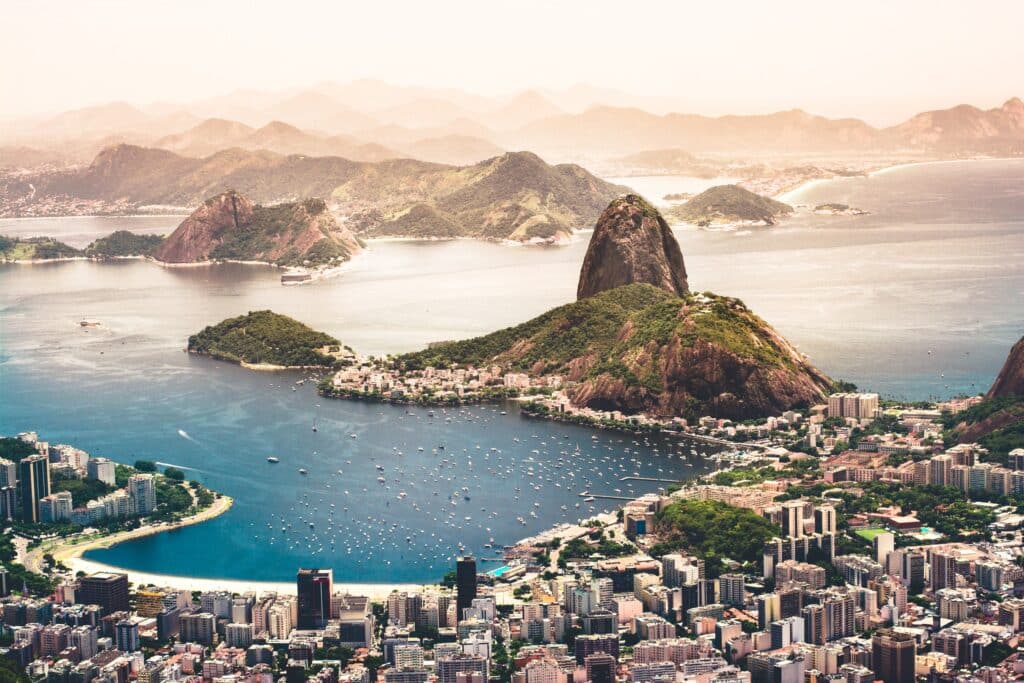The Brazilian population in the United States is relatively small, numbering approximately 460,000 as of mid-2019. This is just 1% of the 44.5-million total immigrant population in the country.
Brazilian migration to the U.S. is also relatively recent transpiration, with arrivals from Brazil only reaching significant numbers from the 1980s onward.
In this article, let’s take a closer look at the history of Brazilian immigration to the United States.

An Overview of Brazilians in the United States
With an increase in Brazil-born residents in the United States, Brazilian American communities have become more visible and better understood.
According to the data in 2017, Brazilian immigrants are younger on average than overall immigrant populations and slightly older than the U.S.-born population.
As a group, the population is well-educated, participates in the workforce at higher-than-average rates, and are more likely than other immigrant groups to be proficient in English. Of Brazilian Americans ages 25 and older, 42% hold at least a bachelor’s degree (compared to 31% for all immigrants and 32% for native-born Americans).
They also have higher-than-average rates of participation in the labor force, and higher household incomes than both foreign-born and native-born groups. Approximately 36% of Brazilian Americans work in management, business, science, and arts occupations, and around 25% in service occupations.
A Brown University publication reported that most Brazilians arrive in the U.S. with the intention of working for three to five years. Most aimed to gather savings to invest in housing or businesses upon returning to Brazil. This is typical of a “yo-yo migration” pattern.
Brazilians in the U.S. retain close ties to home and travel frequently between the two countries. Global remittances to Brazil were over $3.5 billion in 2020, according to World Bank data.
Just a few famous Brazilian Americans include the late singer and actress Carmen Miranda; model and entrepreneur Gisele Bundchen; and Rio de Janeiro-born musician and member of rock band The Strokes, Fabrizio Moretti. Businessman David Neeleman, the founder of the JetBlue airline, was born in Sao Paulo and raised in Utah.
A History of Brazil-to-U.S. Migration
Statistically, few Brazilians migrated to the United States before 1980. The first migration waves took place throughout the 1980s and 1990s, driven by hyperinflation and poor economic conditions in Brazil. The statistics remained steady from the 2000s to early 2010s, with a surge between 2014 and 2017 driven by a 2013 recession in Brazil. They’ve brought their language, cuisine, music, and other traditions from Brazil along the way.
In more recent years, Brazilians have become one of the fastest-growing immigrant groups in the United States. Between 2010 and 2017, there was a 32.8% increase in immigration from Brazil. Figures rose from 340,000 immigrants from Brazil in 2010 to 451,000 in 2017. This made Brazil the 12th fastest-growing country of origin for U.S. immigrants over that period.
In 1980, there were approximately 40,000 Brazil-born residents in the United States. This figure had doubled by 1990s, increased to over 200,000 by the year 2000; reached 340,000 by 2010, and in 2017 had risen to 451,000.

Why do Brazilians Emigrate to the U.S.?
In line with the largely economic driving forces of migration, most Brazilian immigrants to the United States are from Brazil’s middle and lower classes. The very poorest and richest Brazilians are far less likely to migrate.
Middle- and lower-class Brazilians were drawn to migration starting in the 1980s by the relative economic conditions of Brazil and the United States. Brazil was experiencing hyperinflation that made the cost of living very high relative to wages and made it very difficult for Brazilians to save money for the future. Wages for the same jobs in the U.S. were typically four times higher than in Brazil, and economic conditions were generally more stable as well.
In 2017, approximately two-thirds of immigrants from Brazil were immediate relatives of U.S. citizens; the second-largest group migrated for employment opportunities.
Where do Brazilians Live in the United States?
Representations of Brazilian immigrant culture—such as restaurants, festivals, and organizations—are most visible in major population hubs including the Greater Boston area, Greater Miami, and Manhattan’s Little Brazil neighborhood.
Half of all Brazilian-born Americans live in just three states: 80,000 in Florida; 65,000 in Massachusetts (mostly Greater Boston); and 39,000 in California (most in Los Angeles County). New Jersey and New York combined are home to over 50,000 Brazilians.
Here are the largest U.S. metropolitan areas with Brazilian-born populations:
- Boston-Cambridge-Newton, 51,000
- New York-Newark-Jersey City, 48,000
- Miami-Fort Lauderdale-West Palm Beach, 47,000
- Orlando-Kissimmee-Sanford, 15,000
- Los Angeles-Long Beach-Anaheim, 14,000
There are smaller hubs of 8,000 to 11,000 Brazilian residents in Connecticut, Washington D.C., the San Francisco Bay Area, Atlanta, and Philadelphia.
Greater Boston
The Greater Boston area claims the highest number of Brazilian-born residents nationwide. Some experts suggest that Boston attracted large numbers of the earliest Brazilian immigrants due to its historic Portuguese-speaking communities.
The cities of Framingham and Somerville in the greater Boston area have the highest concentrations of Brazilian residents. A few notable organizations in the Greater Boston area are the Brazilian Worker Center and the Brazilian Women’s Group.
New York and New Jersey
The Little Brazil neighborhood in Manhattan is one of the most visible hubs of the Brazilian population in the U.S. It has hosted Brazilian Day celebrations annually since 1984. The event created by the local Brazilian American Cultural Center has grown to become one of the largest Brazilian festivals outside Brazil. It attracts over 1 million visitors with traditional foods, samba music, and big-name performers.
The Ironbound district of Newark, New Jersey is home to many Brazilian- and Portuguese-Americans, as are parts of Astoria in Queens.
Florida
In Florida, the major hub for Brazilian-born residents is northeast Miami-Dade County, which includes Miami Beach, Key Biscayne, and Bay Harbor Islands. The many Brazilian restaurants in Pompano Beach reflect the sizeable community there.
The Brazilian-American Chamber of Commerce of Florida was established in 1981 to promote business opportunities in the Brazilian American community.
Edible South Florida magazine profiled the South Florida Brazilian community’s propensity to grow exotic fruits such as cupuaçu, açaí, and jaboticaba. Such produce is sold at local farmers markets to Brazilians seeking a taste of home.
